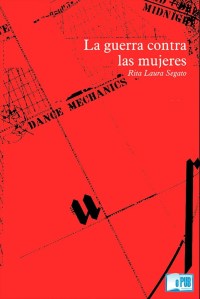Mistral takes advantage of her status as representative, and the representational capacities of language, to make visible the traces of what otherwise escapes the official order of things.
Category Archives: gender
On Nellie Campobello, Cartucho
A conversation for SPAN 312 about Nellie Campobello’s novel of the Mexican Revolution, Cartucho. With Ryan Long and Jon Beasley-Murray.
“Patriarchy: From the Margins to the Center”
Cross-posted to Virtual Koerner’s.
It has been observed that the higher up a corporate hierarchy you look, the more likely it is you will find a psychopath. Indeed, in an article in Forbes (of all places) we read that “Roughly 4% to as high as 12% of CEOs exhibit psychopathic traits, according to some expert estimates, many times more than the 1% rate found in the general population and more in line with the 15% rate found in prisons.” The same article also reports that “the top four career choices for psychopaths are CEO, attorney, media personality and salesperson.” In other words, there is a congruence between psychopathic personality traits and some of the key institutions of contemporary society: business, the Law, the media, and commerce. So much for psychopathy being an “antisocial” disorder. It is part of the very fabric of the world we live in.
 In her chapter, “Patriarchy: From the Margins to the Center” (from La guerra contra las mujeres [2017]), Rita Segato goes further. We are all trained to be psychopaths now, she tells us, as part of a “pedagogy of cruelty” that is the “nursery for psychopathic personalities that are valorized by the spirit of the age and functional for this apocalyptic phase of capitalism” (102). Segato presents a brief reading of Stanley Kubrick’s A Clockwork Orange to make her point, though what she sees as “most extraordinary” about the film is that the shock with which it was received when it came out (in 1971) now seems to have almost totally dissipated. What was once taken as itself an almost psychopathic assault on the viewer’s senses is now just another movie; this shift in our sensibility is “a clear indication [. . .] of the naturalization of the psychopathic personality and of violence” (102). The narcissistic “ultra-violence” of the gang of dandies that the film portrays is now fully incorporated within the social order that it once seemed to threaten.
In her chapter, “Patriarchy: From the Margins to the Center” (from La guerra contra las mujeres [2017]), Rita Segato goes further. We are all trained to be psychopaths now, she tells us, as part of a “pedagogy of cruelty” that is the “nursery for psychopathic personalities that are valorized by the spirit of the age and functional for this apocalyptic phase of capitalism” (102). Segato presents a brief reading of Stanley Kubrick’s A Clockwork Orange to make her point, though what she sees as “most extraordinary” about the film is that the shock with which it was received when it came out (in 1971) now seems to have almost totally dissipated. What was once taken as itself an almost psychopathic assault on the viewer’s senses is now just another movie; this shift in our sensibility is “a clear indication [. . .] of the naturalization of the psychopathic personality and of violence” (102). The narcissistic “ultra-violence” of the gang of dandies that the film portrays is now fully incorporated within the social order that it once seemed to threaten.
For Segato, moreover, this psychopathic violence to which we are increasingly inured is ultimately gender violence: it both establishes and is grounded upon what she elsewhere terms a “mandate of masculinity” by which masculine identity and at the same time both the public sphere and the state is inscribed on and at the expense of women’s bodies. Moreover, all this is folded into a “decolonial” perspective that does not claim that indigenous social structure were free of sexism or patriarchy, but which argues that Western modernity transformed what were once gender relations characterized by reciprocity into a binary system from which empathy is absent and woman are treated as things on which male narcissism inscribes itself.
In short, Segato offers a grand theory of human society and epochal history, at the root of which is (almost) always and everywhere violence against women. As she puts it: “Buried down below, at the foundation, at the foot of the pyramid, sustaining the entire edifice, a woman’s body” (97). As even the reference to a pyramid suggests, confirmed by the frequent invocation of diverse folktales and origin narratives from wildly different contexts, all this adds up to a kind of mythic anthropology that (for all the glancing citations of contemporary theorists such as Judith Butler) has a nineteenth-century feel to it. Indeed, there is a tension between the universalizing gestures on the one hand (an appeal to transhistorical ways of knowing and being), and the attempt to periodize and draw out specificities and differences on the other. Are we all psychopaths now, or is there something psychopathic inherent to modernity? At times, Segato seems to want to have it both ways. Equally, I’m not particularly convinced by her calls to feminine (and indigenous) empathy and reciprocity as modes of resistance to the increasingly violent structure of everyday life, not least because (despite her protests otherwise) all this does indeed sound very much like a form of essentialism.
For me, the parts of Segato’s analysis are very much more interesting and provocative than the whole. I don’t think that we need buy into the (quasi) cosmic unity of her over-arching vision to appreciate the very important ways in which she contributes to our understanding of the mechanisms of gender violence, for instance, not least in her specific studies of cases such as the femicides in Northern Mexico. Even if we see society less as a pyramid (with its base and superstructure) and more as a network or web, Segato’s analyses help us see in new ways how everything is connected, both to ensure the reproduction of forms of domination across many axes, and to offer hope that local resistances can have broad and unexpected repercussions throughout the system. The center has permeated the margins: there are few if any spaces of refuge, and certainly no pre-lapsarian community to which one might fantasize a return. But at the same time, the margins continue to haunt the center: multiplicity is everywhere.
“Las cosas que perdimos en el fuego”
Cross-posted to Virtual Koerner’s.
 Femininity is all too often defined by the image (and so by the male gaze). Women are reduced to appearance, and judged in terms of the extent to which they measure up to some mythical ideal. Mariana Enríquez’s short story, “Las cosas que perdimos en el fuego” (“Things We Lost in the Fire”), presents a surreal and disturbing counter-mythology that explores what happens when that image is subject to attack, not least by women themselves.
Femininity is all too often defined by the image (and so by the male gaze). Women are reduced to appearance, and judged in terms of the extent to which they measure up to some mythical ideal. Mariana Enríquez’s short story, “Las cosas que perdimos en el fuego” (“Things We Lost in the Fire”), presents a surreal and disturbing counter-mythology that explores what happens when that image is subject to attack, not least by women themselves.
It all starts with a woman who is compelled to support herself by begging on the Buenos Aires subway, after a jealous husband inflicts on her horrific burns that destroy her arms and face, leaving her with only one eye and a slit for a mouth, her lips burnt off. As she seeks contributions from subway passengers, she tells her story: that her husband threw alcohol on her face while she was asleep, setting her alight to “ruin” her, so she wouldn’t belong to anybody else. In the hospital, when everyone expected her to die and she couldn’t speak for herself, he said that she had done this to herself, a tragic accident after a fight. Now that she has recovered her voice, the woman on the subway reclaims her narrative and names the perpetrator. She knows, however, that she will never recover her appearance; her image was lost in the fire.
But perhaps it doesn’t all start there. As another character comments later, referring to a history of witch-hunts but also much more, “They’ve always burned women, they’ve been burning us for four centuries!” No doubt this is why the woman on the subway’s story starts to resonate so much with others.
First, it inspires copy-cat crimes: a model, who seems truly to incarnate that idealized image of femininity, is burnt by her footballer boyfriend in much the same way that the woman on the subway had been attacked. And he, too, blames her for what happened. As if it is only in death (the model does not survive her injuries) that women are granted agency, much like the famous if perhaps apocryphal witch-trials by water, in which only the drowned were presumed innocent.
Then, as Enríquez’s story progresses, small groups of Argentine women start to reclaim their agency while still alive, albeit by anticipating the torture inflicted on them by men. They begin to set light to themselves. Some do so alone, perhaps intending suicide. But, in the face of official disapproval, others form shadowy networks of “Burning Women” to aid and abet ritual ceremonies of self-immolation, complete with clandestine hospitals to ensure recovery thereafter. Because the point is to survive, and to put that survival on display. As one woman puts it: “They have always burned us. Now we are burning ourselves. But we’re not going to die: we’re going to flaunt our scars.”
The notion here is a kind of immunization: if women burn themselves, then they also rid themselves of the idealized image, the fetish that justifies men burning them. Moreover, they show that they cannot be reduced to appearances, albeit by paradoxically revelling in the way in which their new, “monstrous” appearance repels the male gaze. As the woman from the subway puts it, “Men are going to have to get used to us. Soon most women are going to look like me, if they don’t die. And wouldn’t that be nice? A new kind of beauty.” Laying claim to deformity, they challenge the gendered scopic regime of representation and power.
Yet this sacrificial logic is disturbing, and not only to men. The story is told from the perspective of a young woman, Silvina, whose mother is one of the first to throw herself into the campaign. It ends as she overhears her mother and a friend talking about her as a possible candidate for a burning: “Silvinita, oh, when Silvina burned it would be beautiful, she’d be a true flower of fire.” Here, the vision is (almost literally) of the Revolution eating its children, of a new image that ends up as horrific and coercive as the old one. The “ideal world of men and monsters” is no more (or perhaps no less) ideal than our own.
There are obvious resonances here with debates over the tactics of militant groups during Argentina’s Dirty War. There is also an explicit comparison to anorexia, which is also as much a self-destructive as a subversive mode of (re)claiming female agency. Perhaps, too, we might think of our contemporary immunological paradigm, and the price we are called upon to pay to confront all manner of diseases (metaphorical and otherwise). Fire both purifies and corrupts. Without nostalgia, and without any easy judgements, Enríquez compels us to think in new ways about what gets lost when we turn the tools that oppress us into weapons for liberation.
